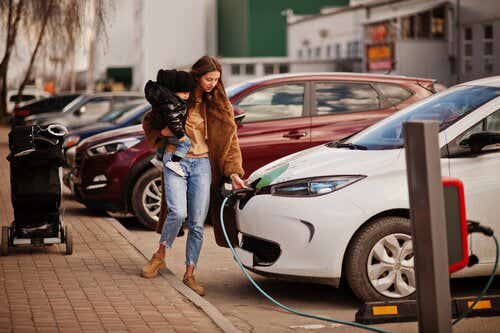We’ve put together a glossary of electric vehicle terms that you might find useful, covering vehicles, charging and terms you won’t hear anywhere else other than in the EV sphere.
Types of vehicle
| Term | Definition |
|---|---|
| Alternative Fuel Vehicle (AFV) | An AFV runs on fuel other than traditional petrol or diesel. |
| Battery Electric Vehicle (BEV) | A car that runs purely on electric power, stored in an on-board battery that is charged from mains electricity (usually from a dedicated home or public chargepoint). |
| Electric Vehicle (EV) | A general term for BEVs, PHEVs and REx, but often used to refer to pure electric vehicles. |
| Fuel Cell Electric Vehicle (FCEV) | These EVs use hydrogen fuel cells to power their electric motors. |
| Hybrid Electric Vehicle (HEV) | An HEV is able to use both electric power and an internal combustion engine, though all its energy comes from petrol. The Toyota Prius is the world’s best-selling HEV. |
| Plug-in Hybrid Electric Vehicle (PHEV) | A car with both a traditional internal combustion engine and a rechargeable battery. This allows the car to either use pure electric-powered driving or enjoy extended range via a combination of the petrol engine and the electric motor. Can be a good middle ground for those who don’t want to go fully electric just yet. |
| Plug-in Vehicle (PIV) | Any vehicle with a plug socket that can be used for charging. |
| Range-Extended EV (REx) | An EV that has a small generator that can be used to charge the battery and extend the vehicle’s range. |
| Ultra Low Emission Vehicle (ULEV) | A car that has official tailpipe carbon dioxide emissions of less than 75g/km - this makes it eligible for government grants and benefits, and enables it to be driven in London’s ULEZ zone without incurring a fine. |
EV charging connectors
| Term | Definition |
|---|---|
| CHAdeMO | This connector is a round plug with four pins, only used for rapid charging points and is usually compatible with Asian-brand EVs - it's worth noting that it's less powerful than a CCS connector. |
| Combined Charging System (CCS) | This EU-standardised connector combines two Direct Current pins arranged below the Type 2 AC connector and uses three Type 2 pins. |
| Type 1 | A Type 1 connector is easily distinguished by its five pin plug - it is common in the US and is typically found on EVs manufactured by Asian and US brands (e.g. Mitsubishi and Vauxhall). |
| Type 2 | A Type 2 connector has seven pins, can carry three-phase power if available and was originally favoured by European brands, though it’s now becoming popular on all cars. |
| UK 3-pin | Fairly self-explanatory, this refers to any plug designed for a standard UK electrical socket. This connector can be used to charge some EVs in an emergency but is far from ideal - it lacks the safety and speed of a dedicated charging point. |
Charging speeds
| Term | Definition |
|---|---|
| Slow charging | A common option when it comes to charging at home, this allows for both top-up and overnight charging through a dedicated charging point which offers faster charging speeds than a three-pin plug. |
| Fast charging | Fast charging points are commonly used for top-up charging while out and about. Typically found in homes, workplaces and public car parks, most of them offer charging speeds of 7 kW. |
| Rapid charging | Rapid chargers (from 43 kW and up) are most commonly found at service stations to be used to top up quickly while on a long journey. |
Jargon
| Term | Definition |
|---|---|
| ICEd | To be ICEd is to be unable to use a charging point because the space has been taken by a car with an internal combustion engine (ICE) which obviously doesn't need to use the charger. |
| Kilowatt-hour (kWh) | A unit of energy used when measuring electricity - this is also the way charging in EVs is measured. |
| Range anxiety | Drivers sometimes get range anxiety when they think they might run out of charge while driving a plug-in electric vehicle, which would leave them stranded. This can be alleviated by topping up the battery wherever you park throughout the day and charging as needed when you take longer journeys. |
| Range per hour | Miles of range given per hour of charge. |
| Single-phase power | Typically found in most UK homes and some businesses, this is what all standard three-pin plug sockets provide. A single-phase electricity supply can power a dedicated charging point up to 7 kW. |
| Smart charging | A catch-all term for a series of functions that a charging station connected to Wi-Fi can do. This usually refers to things like energy monitoring and “managed charging”, i.e. charging at periods of low grid demand and/or high grid supply. |
| Three-phase power | Three-phase power allows for much faster EV charging than single-phase power, but most UK households can’t support it - you’re more likely to find it at rapid charging points and public buildings. |
| ULEZ | A ULEZ (Ultra Low Emission Zone) is an area which requires vehicles being driven in it to meet low emissions standards, or pay a charge. Most of Central London is defined as a ULEZ. |
| Vehicle to Grid (V2G) | You may be able to use your EV’s battery to release power back through the charger either for use in the building it’s connected to or back into the grid in general. |

